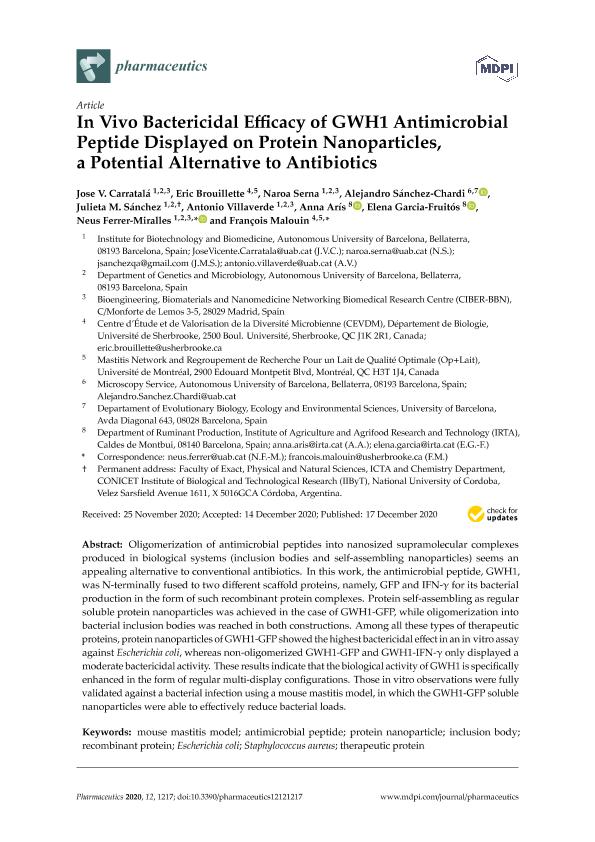Artículo
In vivo bactericidal efficacy of gwh1 antimicrobial peptide displayed on protein nanoparticles, a potential alternative to antibiotics
Carratalá, Jose V.; Brouillette, Eric; Serna, Naroa; Sánchez-Chardi, Alejandro; Sanchez, Julieta Maria ; Villaverde, Antonio; Arís, Anna; Garcia-Fruitós, Elena; Ferrer-Miralles, Neus; Malouin, François
; Villaverde, Antonio; Arís, Anna; Garcia-Fruitós, Elena; Ferrer-Miralles, Neus; Malouin, François
 ; Villaverde, Antonio; Arís, Anna; Garcia-Fruitós, Elena; Ferrer-Miralles, Neus; Malouin, François
; Villaverde, Antonio; Arís, Anna; Garcia-Fruitós, Elena; Ferrer-Miralles, Neus; Malouin, François
Fecha de publicación:
12/2020
Editorial:
MDPI AG
Revista:
Pharmaceutics
e-ISSN:
1999-4923
Idioma:
Inglés
Tipo de recurso:
Artículo publicado
Clasificación temática:
Resumen
Oligomerization of antimicrobial peptides into nanosized supramolecular complexes produced in biological systems (inclusion bodies and self-assembling nanoparticles) seems an appealing alternative to conventional antibiotics. In this work, the antimicrobial peptide, GWH1, was N-terminally fused to two different scaffold proteins, namely, GFP and IFN-γ for its bacterial production in the form of such recombinant protein complexes. Protein self-assembling as regular soluble protein nanoparticles was achieved in the case of GWH1-GFP, while oligomerization into bacterial inclusion bodies was reached in both constructions. Among all these types of therapeutic proteins, protein nanoparticles of GWH1-GFP showed the highest bactericidal effect in an in vitro assay against Escherichia coli, whereas non-oligomerized GWH1-GFP and GWH1-IFN-γ only displayed a moderate bactericidal activity. These results indicate that the biological activity of GWH1 is specifically enhanced in the form of regular multi-display configurations. Those in vitro observations were fully validated against a bacterial infection using a mouse mastitis model, in which the GWH1-GFP soluble nanoparticles were able to effectively reduce bacterial loads.
Archivos asociados
Licencia
Identificadores
Colecciones
Articulos(IIBYT)
Articulos de INSTITUTO DE INVESTIGACIONES BIOLOGICAS Y TECNOLOGICAS
Articulos de INSTITUTO DE INVESTIGACIONES BIOLOGICAS Y TECNOLOGICAS
Citación
Carratalá, Jose V.; Brouillette, Eric; Serna, Naroa; Sánchez-Chardi, Alejandro; Sanchez, Julieta Maria; et al.; In vivo bactericidal efficacy of gwh1 antimicrobial peptide displayed on protein nanoparticles, a potential alternative to antibiotics; MDPI AG; Pharmaceutics; 12; 12; 12-2020; 1-16
Compartir
Altmétricas



